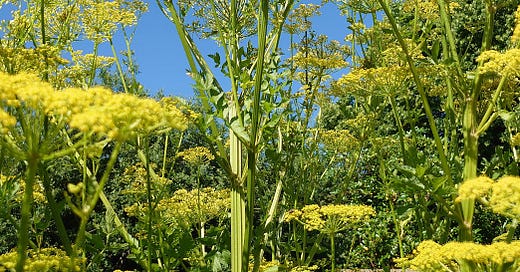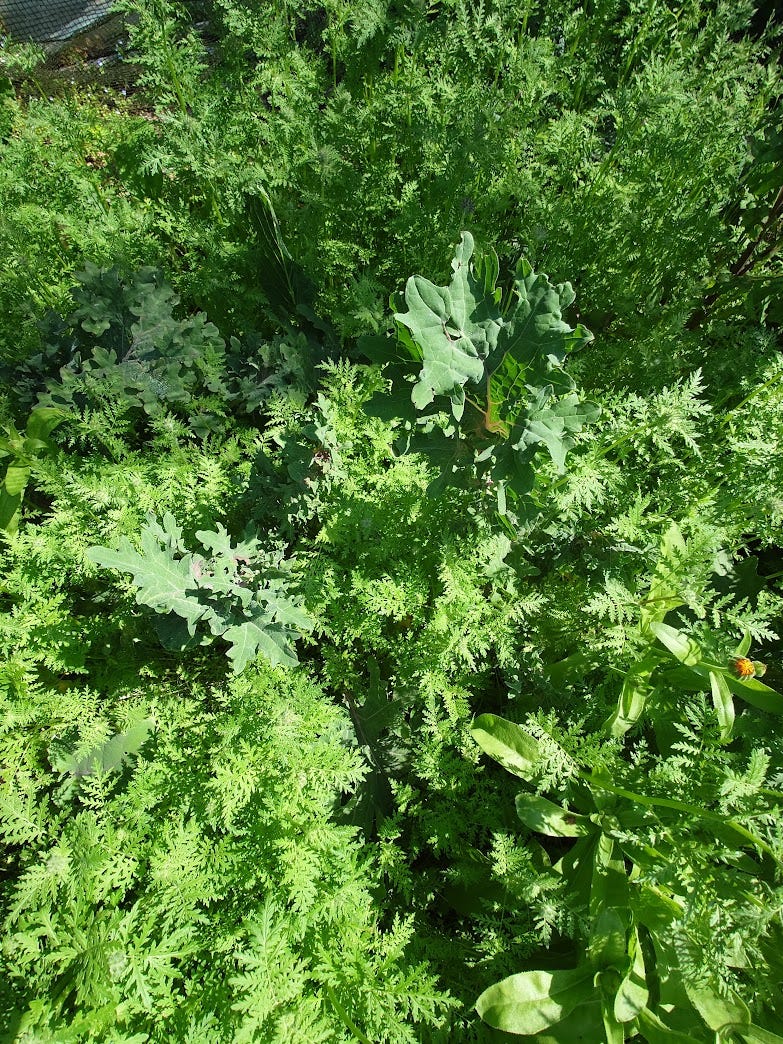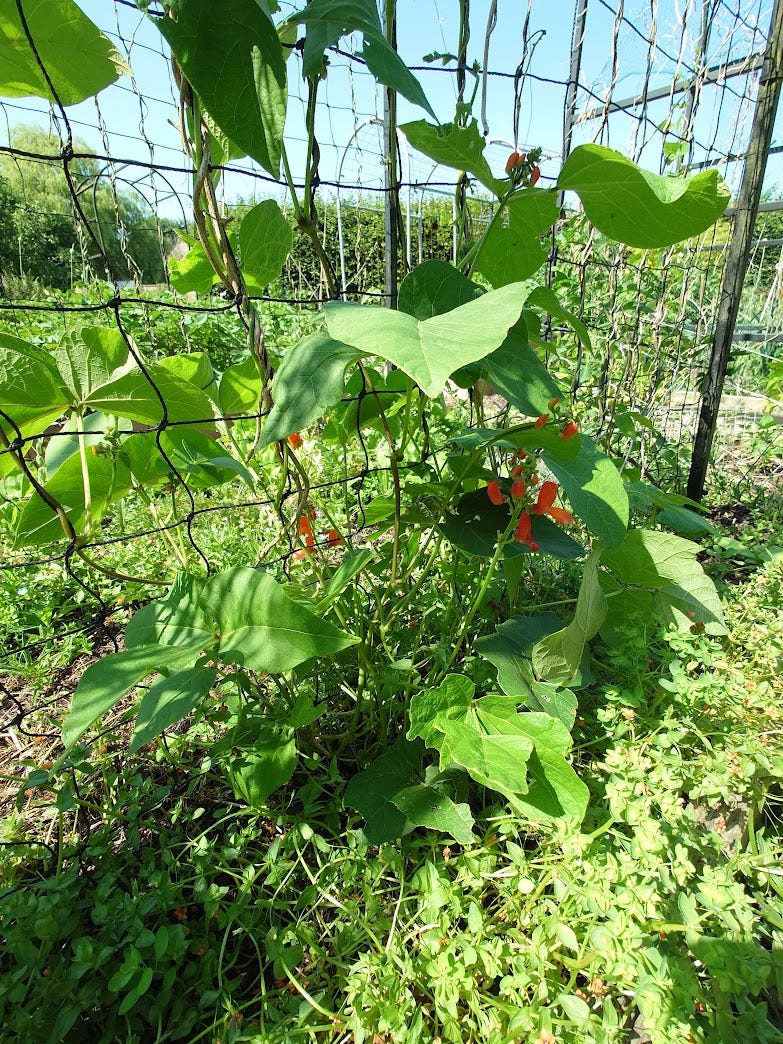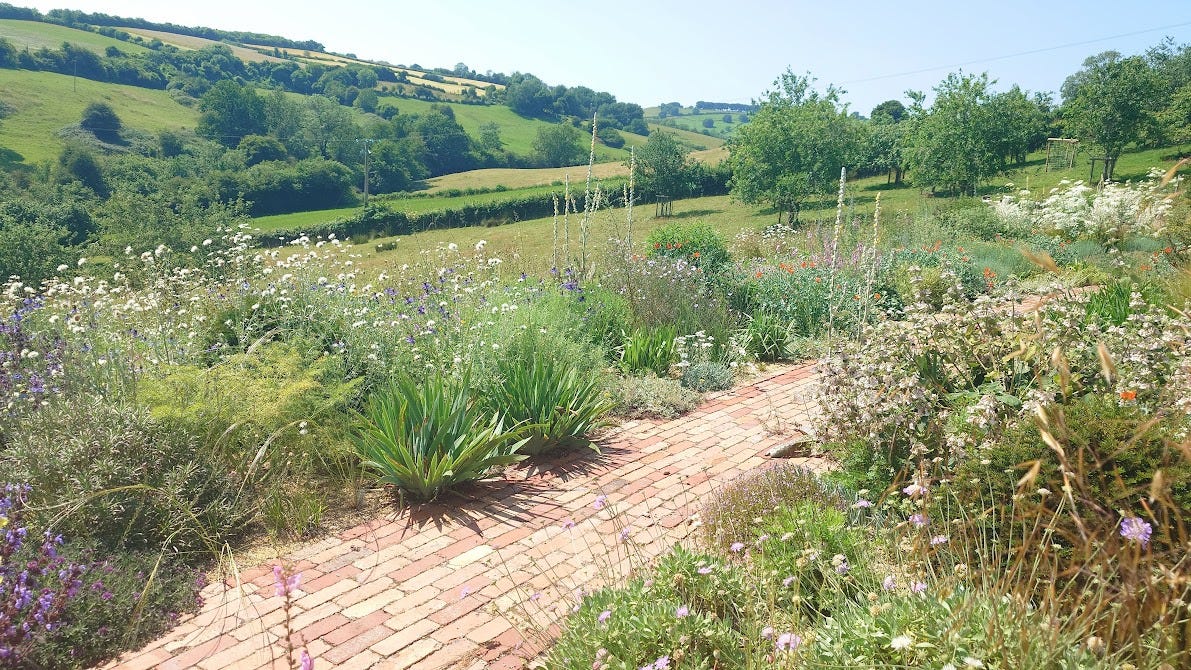Water, heatwaves, and updates on some experiments
This week, the hot weather and watering features, along with some updates on my brassica / living mulch bed, my perennial runner beans plus a taster of designer Dan Pearson's garden in Somerset
🌱 I'm Sally Morgan, an organic gardener and botanist who loves to experiment. Here you can read about matters relating to climate change, sustainability, organic gardening, growing veg and biodiversity, helping you to become a
climate savvy gardener 🌱☀️🌧️❄️🌡️
Hot, hot, hot
The UK is experiencing a period of hot weather with temperatures in the south reaching 30C, competing with temperatures in the Mediterranean. As I write this post, the temperature in the greenhouse is over 40C/ 104F while in the garden its in the high 20C /70s
This spring is now officially the warmest on record and one of the sunniest, with May 2025 being the hottest on record with temperatures reaching 29.3C / 84.7F in Kew Gardens, beating the previous record of 27.4C / 81.3 F set in Lossiemouth Scotland in 1990.
This has been caused by an area of high pressure moving up from the south, pushing the jet stream to the north. In fact, its beeing sunny and dry since March.
Spring seems to be the season that appears to be most affected by climate change, or is it just that we notice the changes more – the blossom, new leaves and the arrival of migrant birds? Not only are we seeing spring arrive by an average of 5 days earlier each decade, but the average spring temperatures in the UK have increased by 1.8C /3.2F since 1970, and 8 of the 10 warmest springs have occurred since 2000.
But looking back over recent spring weather records, no spring seems to have been the same. Last spring was warm, so warm that it set the record at the time for the warmest spring, but it was very different four years ago, when May 2021 was the coldest on record for 400 years. Once again, it was a result of the jet stream , but it was lying to the south of the country, pulling in low pressure from the Arctic.
These patterns are seen elsewhere too. In the USA, the average spring temperatures have risen in most cities by an average of 1.33C/2.4F, with some of the highest increases of more than 3.3C/6F being experienced in Las Vegas, El Paso and Reno.
Comparing notes
This year, I have seen loads of ladybirds and hoverflies in the garden, and now the butterflies are arriving. But if I look back to what I wrote on my blog exactly two years ago, I used the headline ‘Where are all the ladybirds?’ The weather was weird in 2023 with a mild, wet winter and a cold and wet March and April, which then flipped to a hot June. I reported lots of aphids, honeydew on leaves, blackfly on my broad beans etc, but no ladybirds,. At the time it was felt that the weather in April and May had favoured the pest rather than the predator. And looking back to 2021, I reported that during the record breaking cold May, ladybird numbers were down as much as 60% in parts of the UK.
Pest and predators
I get worried when I hear gardeners say they don’t have any pests. You need some pests as food for your predators and you can’t have one without the other. What you should be aiming for is a healthy ecosystem that can cope with a few pests which are kept in check by many different predators. You can’t afford to let the pests get ahead though, so you want to attract the beneficial predators into your garden and keep them there. A small nettle patch, for example, will support aphids early in the year, which in turn, will give ladybirds something to feed on.
Back in April, I let my overwintered brassicas bloom as their flowers are loved by parasitic wasps and it draws them into the garden early in the year. And then I need to keep them in the garden by providing a steady supply of their favourite flowers such as phacelia and overwintered parsnips which are looking lovely at the moment.
Parasitic wasps are very welcome as they lay their eggs in caterpillars, including those of the cabbage white and ‘eat them alive’. There are more than 6,000 species of parasitic wasps in the UK alone, ranging in size from tiny to several centimetres long. If you want the learn more - check out this gory article: The body snatchers – eaten alive. https://www.nhm.ac.uk/discover/body-snatchers-eaten-alive.html
Hoverflies are important too, and again through careful choice of flower, you can attract them to your garden all summer. This week there are lots of hoverflies around, both in numbers and species, more than I have seen for a while which is great news. About half of the hoverflies in the UK have larvae that eat small sap-sucking insects. But be careful, the hoverfly larva looks a bit like a tiny slug. and so many gardeners have told me that they squish them! So know your larvae!
Watering, mulches and hugel beds
With no rain and high temperatures, parts of the garden are suffering from water stress and my water reserves are dipping again. I try to water heavily but infrequently, hoping that a good deluge will get the water where the plants need it - around their roots - and with a mulch in place, it will keep them going a few weeks or more.
I tend to leave my perennial beds to their own devices, so it was interesting to read Kate Bradbury’s latest post where she mentioned that water stressed plants don’t produce as much nectar which affects the insects. I have noticed that my rambling roses have finished quickly this year, so may be its a result of me not giving them any supplementary water?
This year my hugel bed has been planted with potatoes. Potatoes are vulnerable to drought, especially during key phases such as tuber initiation and bulking up, but I don’t think I have needed to water the bed once as the soil has really held onto moisture. I created it a couple of years ago by filling a deep raised bed with old logs, wood chips, and other woody material which was topped off with compost and soil - all that woody material acts like a sponge, holding onto moisture, so the plant roots and their mutualistic mycorrhizae can find plenty of water.
And there was an interesting comment on a garden visit yesterday (see below) about mulching and how mulches behave differently. A mulch of compost tends to wick moisture up from the deep soil, whereas a mulch of sand creates a cap, so the soil stays moist underneath, so I need to investigate this some more.
Living mulch experiment
I wrote about living mulches last week so I thought I would show you one of my experimental brassica beds. I don’t rotate my brassicas anymore and I’ve grown them on the same bed for four years now. This year I am trialling a living mulch – a cover of phacelia around the kale. The phacelia is quite dense and growing tall, but the kale plants seem to be coping. Again, I’ve not had to water since establishment. The kale were planted out after I had sown the phacelia and the seedlings were just showing. One of the advantages of phacelia is that the flowers attract parasitic wasps and hopefully this will keep any cabbage white caterpillars in check!
Have I mentioned that runner beans can be perennial?
Can’t remember! This photo shows one of my perennial runner beans that is now three years old. It got away well in May and now has 6 shoots and flowers. By perennial I mean, I leave my runner bean plants in the ground after harvest and if I am lucky, they survive the winter and re-appear the next spring. It doesn’t always work - if the winter is too wet, too cold et they rot, but now I have three perennial runner bean plants entering their third year and they have extensive root systems. One of the advantages of not rotating my legume bed!
And finally a taste of what’s coming next week
Yesterday, I joined a Garden Masterclass visit to the fabulous Hillside Garden of Dan Pearson, which lies just outside Bath. Here, Dan and Huw have created a garden that hugs the contours of the slope, and connects with and is part of the surrounding landscape, as you can see from the photos. There are soft borders, winding paths, natural textures and so much more. Of particular interest to me was Dan’s latest venture, a Sand Garden planted on 150mm of coarse sand where he is growing a wide range of Mediterranean plants. I will be covering this garden and that of James Hitchmough next week - you won’t be disappointed.
If you are interested in garden design, check out the Garden Masterclass website where you will find lots of events (in person and remote), webinars and Thursday chats.
Happy gardening
PS If you enjoyed reading this post, please click the ‘like’ button at the bottom, it really helps make my posts more visible on the SubStack app. Thank you xxx
Talks in 2025
1 July Sherston, near Malmesbury
9 July Bramzero, Calne
21 July Bride Valley near Dorchester
1 September Wootton Bassett
2 September Marshfield
4 September Dilton
18-20 September I will be at Yeo Valley on 18 and 19 Sept. Do come along. There is a huge line up of speakers, Yeo Valley Organic Garden Festival
2 October Ringwood
9 October Seavington
10 October Box Garden Club near Chippenham
11-12 October Bury St Edmunds Literary Festival I am teaming up with Becky Searle (IG sowmuchmore) to give a talk and run a workshop on Boosting biodiversity in the garden. Come along and join us! Programme here
13 October Rode, nr Frome












Looking forward to reading more about your investigation of various munches, Sally. My garden is all about mulching and haven't got a single patch of naked soil.
Love the tip about phacelia and kale!